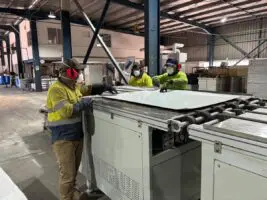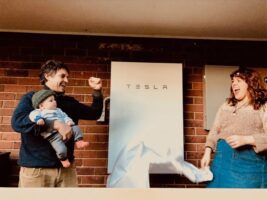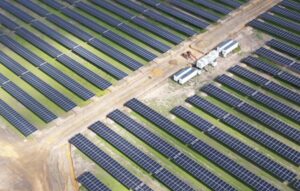Andrew Vesey, the head of Australia utility AGL Energy says that technologies in the electricity sector are changing so quickly that he not sure what the business model for the sector will turn out to be.
Vesey, in Paris to attend functions associated with the UN-sponsored climate negotiations, said technologies were getting smaller and smaller. And it will be up to the customer to shape how the energy industry evolves.
 He said new business models will evolve, which will be largely based on how customers respond to new technologies – such as rooftop solar, battery storage and the “internet of things”, and the value chains these create.
He said new business models will evolve, which will be largely based on how customers respond to new technologies – such as rooftop solar, battery storage and the “internet of things”, and the value chains these create.
“We have to have new business models to adapt to these new technologies,” Vesey said.
“I don’t know what they are yet. That’s the challenge we have, and that’s where innovation comes from. (We know) it’s going to be different.
Vesey said he already had to adapt the business model of the group once, following the purchase of its huge portfolio of coal-fired power stations under his predecessor Michael Fraser.
“When I first heard of this job, I looked at what AGL was and it said Australia’s largest owner and operator of renewable energy. By the time I got down here it was the country’s biggest emitter.
“So the first challenge I had when coming down here was in de-risking that portfolio.”
Vesey is now looking at the consumer end of the market. He has created a New Energy division that ranks equally – although not yet in revenues or profits – with its established generation and retailing businesses.
It is looking at a range of new technologies – rooftop solar, battery storage, electric vehicles, and smart controls – and already has three different battery configurations now out in the market, and is exploring the smart meter market.
“We haven’t yet caught up with the consumer market,” he said, later adding that it was not clear exactly what the consumer wanted to get out of these technologies.
One offering he flagged was the creation of a “virtual power plant”, that would allow the aggregated output of 1,000 homes with batter storage (and presumably solar) that could be controlled and shared, and sold.
“The question is how the consumer can get involved in that. That is what we are trying to move to. That where we have to create.”
He then added: “We haven’t put to the market a value proposition that makes sense in terms of managing the distributed energy within the system.
“We have to have new business models to adapt to these new technologies.
“We have to give customers simplicity. Once you have rooftop solar and battery you have seven flows of electricity and cash to manage. “That too complex. We have to make it easier for people to profit from those.”
Later, after the event, RenewEconomy managed to doorstop Vesey and asked him to expand on what he thought the future business model would be. We thought we’d download the whole answer, just to give an insight into the thinking of one of Australia’s biggest utilities:
“I wish I had an answer for you. But the fact is I think it is right for a rethink, and the reason is that the technology is different.
“If someone wants to buy solar rooftop, or battery storage, is it for control? I don’t know if it is. The question is: What is the utility that is being provided, what’s the product.
“My sense is with the movement of sensing technology, and metering technology and all the capability that you can drive right down to the end-user, there is a different model than just a commodity being paid for in a simple transaction.
“There was a very interesting paper written in 1978, it was called the homeostatic control of electricity systems. And it was being written at the time at MIT, basically making an argument for real-time pricing, if you sent a real-time price, people would change their consumption.
“Basically the theory was that the incremental electron that is consumed by any end user at any point of time is different in terms of value to any other end user. So there is always an arbitrage opportunity.
“There was a phrase in the paper that said, and with the advancements of computational capability the future is not far away. Well, that future is here now.
“So, if that’s true, and you have batteries, you can produce your own stuff, and you can take it off the grid, and there are a lot of users there, people can be trading. You buy it and then you trade it.
“Now think about the internet of things, where it is not the end user, it’s the end user device. 50 billion things connected ..probably the most efficient network. So you will need less invested in generation, so read that as less environmental impact.
“In order to do that it is not the traditional model we have , it’s not I produce it in the big plant and I sell it to you by the pound and I hang a credit meter on your wall.
“So what is it? That’s what really has to be explored. And it seems that it going to come from one or two places, it’s going to come from a guy that developed Uber, and now decides he’s going to be in the electric business, and he’s not going to be constrained by the paradigms I grew up with since the 1970s.
“We’re really challenging ourselves, how else we want to approach the customer, how do we want to change that relationship, how are we going to use the technology that is available, whether it storage or generation, or just an app on your smart phone to change the way you manage and consume electricity.
RenewEconomy then asked whether AGL would face the same pressures, or the same opportunities, as other major utilities around the world – such as NRG in the US, and RWE and E.ON in Europe – to split its business between the old and the new, effectively siphoning off the ageing and polluting centralised generation into a different company to the retail operations servicing a rapidly changing customer base.
This is what Vesey said:
“What we’ve done is we’ve changed our business definition. When people say are you a retailer, you a generator, you a gentailer, no we’re in the business of harnessing insights to enrich our customer’s experience.
“I will do whatever I need to do to deliver that to my customers, and how we organize back up the thing will be determined by the best way to deliver on that definition. This is not as simple as Old Co and New Co, this is not a financial issue, it is a question of how to organize to deliver value to your customer.”








